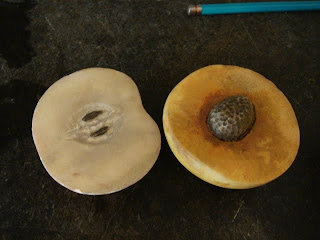The earlier hog scraper candle sticks actually were made in Europe, mostly in England, but also France and Holland. Most of the early lighting used in this country was made in Europe. This was partly because of the laws that prevented us from making our own, to protect the English manufacturers, and partly because our technology just wasn't advanced enough at the time. Hog scrapers, like much other lighting is made from tinned sheet iron, and it would take quite a force to make fine even sheets of iron, and then to mold the sheet of iron into the forms we love today. The first known patent for an American hog scraper was in 1853.
I think all the early hog scrapers had a hook extending from the top edge, called a hanger. This was to hang to candle stick from your chair back or a nearby shelf to get the light closer to your work or your book. Be careful, don't burn your wig! Actually, if you look you can sometimes see burn marks on the top slat of a chair or the the top of a settle. In the pic above on the right you can see a proper hanger. Hangers are always wider where they attach to the candle stick top. If not, see the bit about fakes below. On the left stick you can see where the original hanger was broken off. They often broke, partly I suppose because that part is fairly thin.
Here is a pic of the base of the three main eras of hog scrapers. On the right is the earliest type, supposedly made in the 18th C. It has two "tabs" that come down through two slots in the base, and then are "cleated" or pounded over to hold the whole stick together. These 18th C sticks are the rarest on the market, as you might imagine. Maybe 1 in 50 hog scrapers are this early type. They also usually cost more. The middle base is from the classic form of hog scraper you usually see in pictures or in the market. They are made in the 19th C. still usually made in Europe. After the Revolution we began to make more of our own goods. This type has a nut that attaches to a screw that is inside the tube part, screwing it down tight to hold the whole stick together. Once in a while you see washers or other devices to hold the nut on tighter as it wore down from use. On the left is what is called the American hog scraper. These are generally considered to be made in the US. The metal is a little lighter, and you can see the ring that clips on and holds the whole thing together. So you see, if you look at the base, you can always date your hog scraper.
Here is the "donut" as seen on both the 18th and 19th C candle sticks.
 Here is what is called the Wedding Band hog scraper. You can see the brass "wedding" band in the middle. Just a little glitter for that dark Colonial interior. Again these are fairly rare on the market. As you can imagine they cost more in the day, and fewer people could afford to buy them. Beware, beware! I can't find a pic to show you, but there are so many fake wedding bands out there. It is so easy to cut a hog scraper candle stick "shaft" and solder a brass ring in the middle. But if you look carefully, you can see the solder ring on each side of the brass one, which you cannot see in the old ones.
Here is what is called the Wedding Band hog scraper. You can see the brass "wedding" band in the middle. Just a little glitter for that dark Colonial interior. Again these are fairly rare on the market. As you can imagine they cost more in the day, and fewer people could afford to buy them. Beware, beware! I can't find a pic to show you, but there are so many fake wedding bands out there. It is so easy to cut a hog scraper candle stick "shaft" and solder a brass ring in the middle. But if you look carefully, you can see the solder ring on each side of the brass one, which you cannot see in the old ones.Here is a pic of a repro I copied off the internet. Note the long curved hanger. Even if this one had been left out in the rain and got rust and patina, even then you would be able to recognize it. Also, notice the donut is not made separate, but is one piece with the base.
References
Here a few good books I used and I recommend
Colonial Lighting Arthur Hayward Dover
Candle Holders in American Joseph Butler Bonanza
Fire and Light in the Home John Caspall Antique Collector Club




























